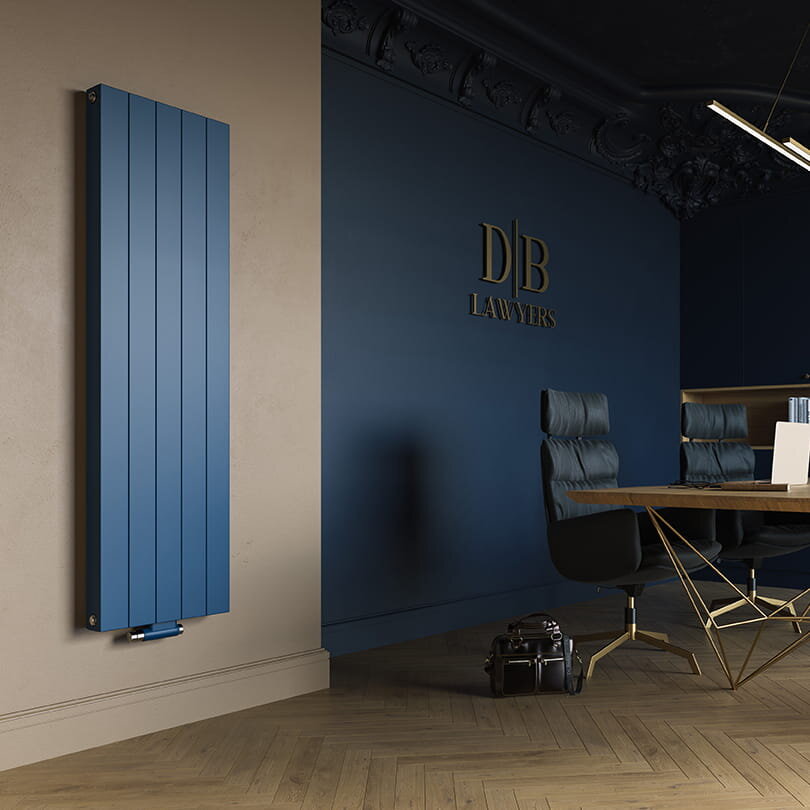Ensuring comfortable conditions to work
It has become essential, nowadays, to provide a comfortable indoor climate within workplaces.
Maintaining productivity, concentration, and good well-being in offices starts with providing the right indoor climate with proper office heating and cooling.
A constant flow of fresh air via a good ventilation system is also crucial, and studies show that an optimal temperature can positively affect production.

Office and workplace heating and cooling
There are many possibilities to tackle good indoor climate comfort solutions in workplaces.
These include standard panel radiators, radiant heat panels for ceilings, underfloor heating and cooling systems, fancoils, and ultra-low temperature radiators.
The significant rise in people working from home has drawn attention to creating a comfortable and productive work environment.
This not only means having an ergonomic chair and desk but also good lighting and a pleasant room climate, which you’ll achieve with, for example, plants that filter the air, regular ventilation, and an ideal room temperature.
Whatever your project, it is essential to choose the proper solution to create an optimal indoor climate in an environment where we spend so much of our time.
Solutions
The critical aspects for choosing the right office heating and cooling and ventilation are:
Good, draft-free ventilation and cooling
Optimal temperature
Silent solution

Large office buildings: reducing the carbon footprint
New larger office buildings commonly opt for radiant heating panels for ceilings as their heating solution. It is a device that can be controlled externally to avoid any excessive heating and energy consumption.
Large enterprises tend to have a significant impact on the climate, so their environmental responsibilities are more significant. Therefore, there is more pressure on them to set an example in reducing their carbon footprint! These radiant heating panels are also compatible with low temperatures and renewable heating sources like heat pumps.
Another low-temperature solution for offices can be underfloor heating and ventilation convectors, which can also be controlled externally.
Most of the time, these convectors can also cool the room in the summertime.
Small offices
As smaller office buildings tend to resemble the residential market, more flexible and adjustable heating solutions can be used.
Radiators can react quickly to changing demands for office heating and can be adjusted to provide flexible comfort levels. Rapid responses are enabled by the combination of small thermal mass and well-emitting materials in steel radiators.
When using a heat pump as an energy source, underfloor heating and convectors are the perfect combination of constant, flexible heat.
Comfortable home office
In the past, working from home was mainly associated with freelancing. However, over the last few years, many people have discovered the benefits of working in the comfort of their own home. Obviously, a better work-life balance is one of them, but remote work also gives you the opportunity to create a comfortable home office that is perfectly tailored to your needs.
Some of the first things that come to mind when creating the ideal home office are good lighting and ergonomic furniture. However, it’s equally important to have an efficient heating solution that ensures an optimal temperature throughout the day, and that’s precisely what our radiators are designed for.
Interview with an expert
Christophe Raes, project manager, Belgium
Trying to create the ‘perfect’ climate in an office is a tough challenge due to the many factors we must consider. A healthy indoor air must be provided at the right comfortable temperature in all the seasons of the year, so it has become crucial to provide systems that can do both heat and cool. It is important to achieve a uniform temperature over the entire space in a large office space with often flexible workplaces. Climate ceilings are often used for this purpose, with or without additional underfloor heating.
In meeting rooms where the need for heating or cooling is highly dependent on the number of people, it is advisable to use supplementary fan convectors. In addition to choosing the right heating and cooling system, it is also important that good sun protection systems are installed in offices with a lot of glass to limit external influences on the indoor climate.




